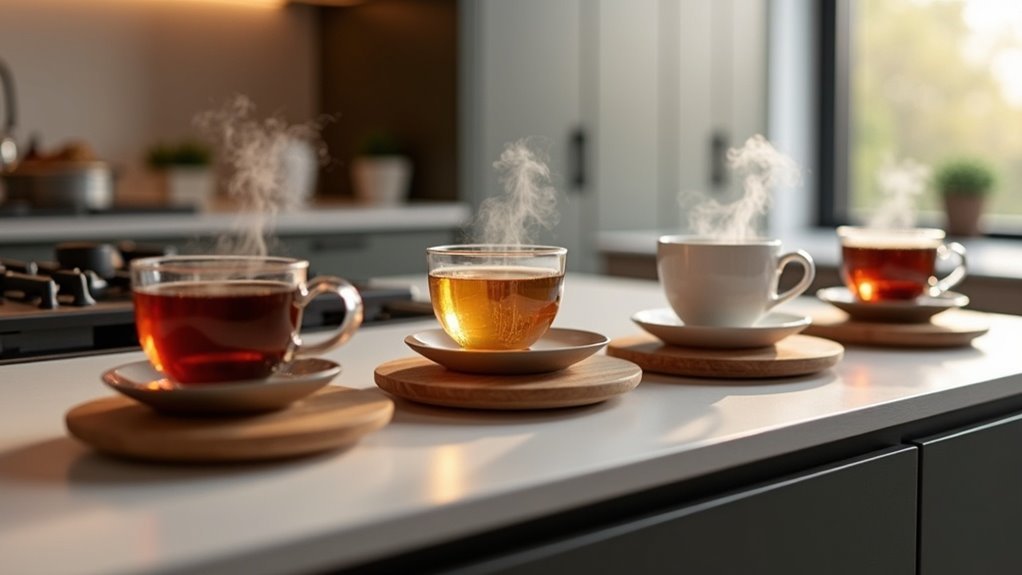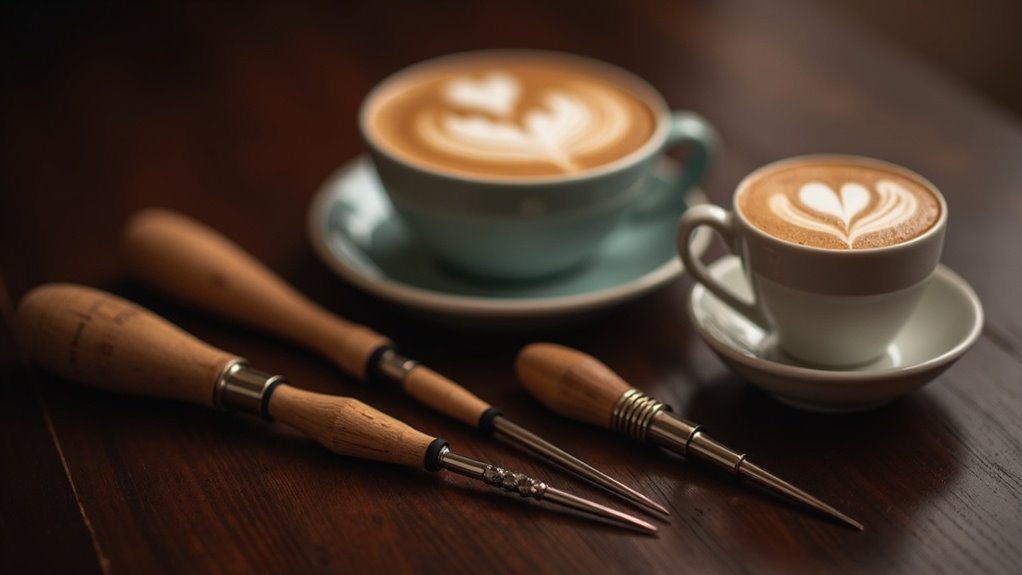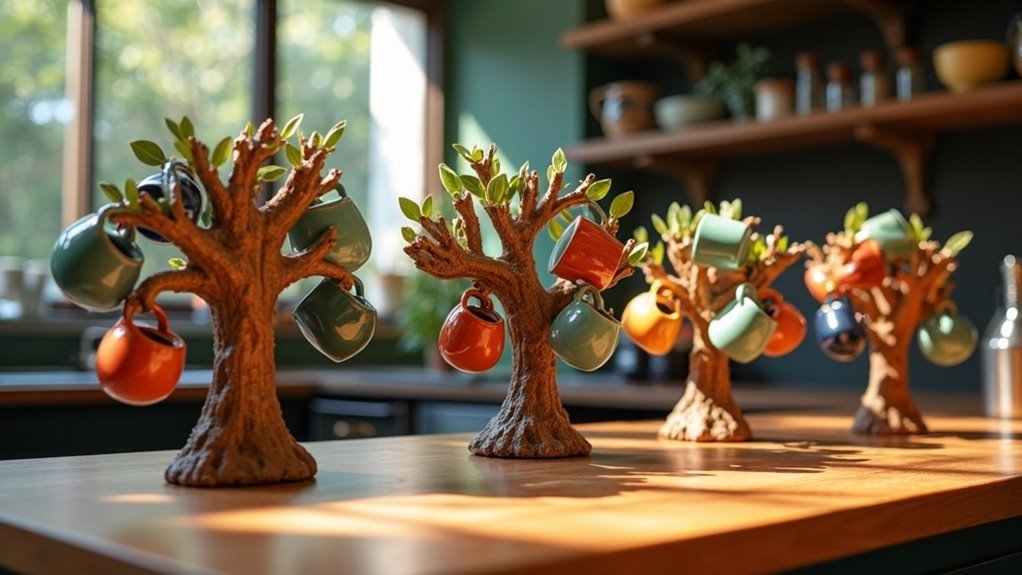Indian filter coffee is a beloved beverage that blends robust flavor with rich tradition. Originating in the 17th century, it features a mix of dark roasted coffee and chicory, brewed slowly for a uniquely aromatic experience. The preparation process is highly ritualistic, creating a sense of nostalgia and community around this delightful brew. Served traditionally in a tumbler and davara, Indian filter coffee fosters connections while showcasing India’s rich cultural heritage. Discover how to perfect this exquisite coffee and elevate your own coffee experience.
Key Takeaways
- Indian filter coffee has its origins in the 17th century and is an integral part of the country’s cultural traditions and social interactions.
- This coffee is crafted from dark roasted arabica beans mixed with chicory, which enhances its flavor and richness.
- The brewing process utilizes a traditional cylindrical filter, allowing for a unique percolation method that optimizes the coffee’s taste.
- Typically served in a tumbler and davara, the coffee is poured back and forth to create a frothy texture and to cool it down.
- Sweeteners such as jaggery or honey can be added to personalize the flavor, reflecting individual preferences and cultural significance.
History of Indian Filter Coffee
When you explore the history of Indian filter coffee, you’ll discover a fascinating journey that dates back to the 17th century, marked by the intrigue of smuggling and cultural exchange.
This beloved beverage, known as kaapi, began its roots in Karnataka’s Baba Budangiri hills, thanks to Indian Sufi Baba Budan.
The British colonial era saw coffee production soar with large plantations in Coorg, enhancing its popularity.
The establishment of the Coffee Board of India in the 1940s further regulated and promoted coffee.
Today, the unique brewing method using a stainless steel filter pot is integral to South Indian culture and tradition, making it a distinctive aspect of coffee appreciation in the region.
Ingredients Used in Filter Coffee
When selecting beans for Indian filter coffee, you’re likely choosing between Plantation A washed arabica or Peaberry, both renowned for their rich flavor and captivating aroma.
Incorporating chicory not only enriches the coffee’s robust profile but also adds a touch of bitterness that beautifully balances its natural sweetness.
This thoughtful combination of ingredients elevates your morning brew into an irresistible experience.
Coffee Bean Selection
Selecting the right coffee beans is essential for crafting the perfect cup of Indian filter coffee. Opt for Plantation A washed arabica or Peaberry coffee beans, known for their rich flavor profiles.
Typically, dark roasted and finely ground, these beans create a robust base for your coffee blend. A traditional mix consists of 80-90% coffee and 10-20% chicory, adding depth and a hint of bitterness.
Experimenting with brands like Cothas can elevate your experience, as combining different brands enriches the flavor.
Chicory’s Flavor Contribution
While many may concentrate on the coffee itself, chicory significantly influences the distinctive flavor profile of Indian filter coffee.
Typically making up 10-20% of the coffee blend, chicory introduces a pleasing bitterness and depth, enriching the overall complexity. The common ratios of 15:85 to 20:80 allow for a personalized taste experience.
Historically, chicory became prominent during coffee shortages in the 17th century and has since become a vital component of traditional recipes.
In addition to enhancing flavor, chicory offers health benefits by lowering caffeine intake. Incorporating chicory into your coffee can elevate your experience while honoring a beloved tradition.
The Brewing Process
To create the perfect cup of Indian filter coffee, you need to master the brewing process, which is both art and science. Start by using a cylindrical filter: place coffee grounds in the upper chamber, pour boiling water, and secure the lid. Allow the coffee to percolate for 20-30 minutes, letting the rich decoction drip into the lower chamber. Don’t forget the pressing disc—it enhances flavor extraction! Finally, mix your brew with hot milk and sugar, frothing it for that authentic touch. Here’s a quick guide:
| Step | Action | Time |
|---|---|---|
| 1 | Add coffee grounds | – |
| 2 | Pour boiling water | – |
| 3 | Brew with lid on | 20-30 mins |
| 4 | Mix with hot milk and sugar | – |
Enjoy your journey through the world of coffee!
Cultural Significance of Filter Coffee
As you explore the world of Indian filter coffee, you’ll discover its deep-rooted cultural significance, especially in South India.
Filter Kaapi isn’t just a beverage; it embodies nostalgia and personal memories tied to family traditions. Its preparation and consumption involve rituals that offer comfort during both ordinary and uncertain times.
Once seen as an upper-class drink, filter coffee has influenced social dynamics and caste struggles. Coffee shops serve as essential gathering spaces, emphasizing hospitality and community.
Shared coffee experiences often mark the shift from childhood to adulthood, reinforcing its role in shaping personal and cultural identity within South Indian food culture.
Enjoying filter coffee isn’t just about savoring a drink; it’s an immersion into a rich tapestry of cultural heritage and social connections.
Coffee Powder Selection
Choosing the right coffee powder is key to brewing an authentic cup of Indian filter coffee that resonates with tradition and taste.
Opt for finely ground Plantation A washed arabica or Peaberry coffee beans for a rich flavor. Popular brands like Cothas often shine, but don’t hesitate to explore and blend different varieties for a personalized touch.
Incorporating chicory in a 15:85 or 20:80 ratio can enhance depth and add a subtle bitterness.
Serving and Enjoying Filter Coffee
When you serve Indian filter coffee in a tumbler and davara, you’re not just enjoying a beverage; you’re engaging in a beloved cultural tradition.
The frothing technique, achieved by pouring back and forth, enhances the flavor profile, transforming each sip into a delightful experience.
Feel free to customize your drink with sugar, jaggery, or even enjoy it iced, and you’ll discover how this traditional coffee adapts to personal preferences while fostering connections with others.
Traditional Serving Techniques
Serving Indian filter coffee isn’t just about the beverage itself; it’s an art form that enhances the overall coffee experience.
You begin by pouring a strong decoction into the davara, then adding hot milk, ensuring that each flavor’s integrity is preserved. This ritual involves pouring back and forth between the tumbler and davara, which cools the coffee to the perfect drinking temperature while creating a delightful froth.
The communal aspect of serving coffee fosters connections among friends and family, turning coffee time into a cherished gathering.
Whether enjoyed hot or as a refreshing iced version, each cup of Indian filter coffee reflects a rich and inviting tradition that every coffee lover can appreciate.
Enhancing Flavor Profiles
Elevating the flavor profiles of Indian filter coffee involves a delicate balance of technique and ingredients.
To truly appreciate its rich, earthy notes, serve your hot coffee with scalded milk for a creamy texture. Frothing the coffee by pouring it between a tumbler and dabarah aerates the drink, enhancing its velvety feel and softening chicory’s bitterness.
For the best flavor experience, aim for a chicory-to-coffee ratio of 15:85 or 20:80. A pinch of cinnamon can add a delightful warmth, while iced coffee variations provide a refreshing twist that maintains the robust essence of the brew.
Embrace these methods for a truly satisfying coffee experience.
Cultural Rituals and Gatherings
As you step into a South Indian home, the aroma of freshly brewed filter coffee immediately invites you into a world rich with flavor and tradition.
Filter coffee is made with care, often involving the ritual of pouring it back and forth between a dabarah and tumbler, which aerates and cools the drink.
In South Indian culture, serving coffee isn’t just about the beverage; it’s a symbol of hospitality and a way to create bonds among family and friends.
These moments, centered around enjoying the rich flavors of filter coffee, reinforce connections that span generations and enrich everyday experiences.
Whether shared during casual gatherings or special occasions, filter coffee remains a beloved cornerstone of South Indian culture.
Modern Adaptations and Variations
How has the landscape of Indian filter coffee evolved in recent years? The pandemic sparked a newfound interest in authentic South Indian coffee, making local suppliers like Ministry of Kaapi popular among enthusiasts.
Traditional coffee paraphernalia, including the South Indian coffee filter, has become more accessible for home brewing. Bottled decoction offers convenience, allowing you to enjoy fresh coffee without the wait.
To replicate traditional flavors, chicory-to-coffee ratios of 15:85 or 20:80 are recommended. Innovative products like iD coffee sachets simplify preparation, inviting even the unfamiliar to savor the authentic brewing experience—modern adaptations that keep the rich coffee tradition alive.
Tips for the Perfect Brew
To brew the perfect cup of Indian filter coffee, you’ll want to start with the right equipment and ingredients.
Use a stainless steel coffee filter with two chambers—place your coffee grounds in the upper chamber. For a rich flavor, opt for freshly ground beans, ideally a blend of Plantation A arabica and chicory.
After adding boiling water, let it steep for 20 to 30 minutes. When serving, aerate the coffee by pouring it between a tumbler and a dabarah for that frothy texture.
Finally, adjust your sweeteners, considering jaggery or honey for a uniquely delightful experience. Enjoy your coffee!








